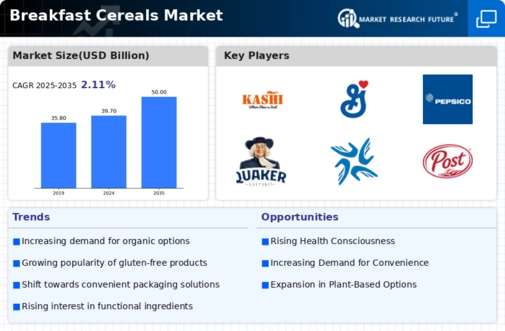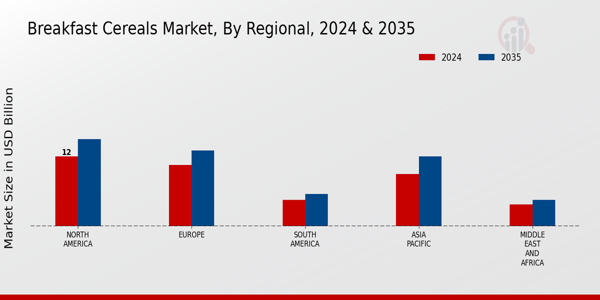Ready-to-Eat Cereals
Cooked Cereals
Instant Cereals
Hot Cereals
Whole Grain
Gluten-Free
Organic
High Fiber
Children
Adults
Seniors
Supermarkets/Hypermarkets
Online Retail
Convenience Stores
Specialty Stores
North America
Europe
South America
Asia Pacific
Middle East and Africa
North America Outlook (USD Billion, 2019-2035)
North America Breakfast Cereals Market by Product Type
Ready-to-Eat Cereals
Cooked Cereals
Instant Cereals
Hot Cereals
North America Breakfast Cereals Market by Ingredients Type
Whole Grain
Gluten-Free
Organic
High Fiber
North America Breakfast Cereals Market by End User Type
Children
Adults
Seniors
North America Breakfast Cereals Market by Distribution Channel Type
Supermarkets/Hypermarkets
Online Retail
Convenience Stores
Specialty Stores
North America Breakfast Cereals Market by Regional Type
US
Canada
US Outlook (USD Billion, 2019-2035)
US Breakfast Cereals Market by Product Type
Ready-to-Eat Cereals
Cooked Cereals
Instant Cereals
Hot Cereals
US Breakfast Cereals Market by Ingredients Type
Whole Grain
Gluten-Free
Organic
High Fiber
US Breakfast Cereals Market by End User Type
Children
Adults
Seniors
US Breakfast Cereals Market by Distribution Channel Type
Supermarkets/Hypermarkets
Online Retail
Convenience Stores
Specialty Stores
CANADA Outlook (USD Billion, 2019-2035)
CANADA Breakfast Cereals Market by Product Type
Ready-to-Eat Cereals
Cooked Cereals
Instant Cereals
Hot Cereals
CANADA Breakfast Cereals Market by Ingredients Type
Whole Grain
Gluten-Free
Organic
High Fiber
CANADA Breakfast Cereals Market by End User Type
Children
Adults
Seniors
CANADA Breakfast Cereals Market by Distribution Channel Type
Supermarkets/Hypermarkets
Online Retail
Convenience Stores
Specialty Stores
Europe Outlook (USD Billion, 2019-2035)
Europe Breakfast Cereals Market by Product Type
Ready-to-Eat Cereals
Cooked Cereals
Instant Cereals
Hot Cereals
Europe Breakfast Cereals Market by Ingredients Type
Whole Grain
Gluten-Free
Organic
High Fiber
Europe Breakfast Cereals Market by End User Type
Children
Adults
Seniors
Europe Breakfast Cereals Market by Distribution Channel Type
Supermarkets/Hypermarkets
Online Retail
Convenience Stores
Specialty Stores
Europe Breakfast Cereals Market by Regional Type
Germany
UK
France
Russia
Italy
Spain
Rest of Europe
GERMANY Outlook (USD Billion, 2019-2035)
GERMANY Breakfast Cereals Market by Product Type
Ready-to-Eat Cereals
Cooked Cereals
Instant Cereals
Hot Cereals
GERMANY Breakfast Cereals Market by Ingredients Type
Whole Grain
Gluten-Free
Organic
High Fiber
GERMANY Breakfast Cereals Market by End User Type
Children
Adults
Seniors
GERMANY Breakfast Cereals Market by Distribution Channel Type
Supermarkets/Hypermarkets
Online Retail
Convenience Stores
Specialty Stores
UK Outlook (USD Billion, 2019-2035)
UK Breakfast Cereals Market by Product Type
Ready-to-Eat Cereals
Cooked Cereals
Instant Cereals
Hot Cereals
UK Breakfast Cereals Market by Ingredients Type
Whole Grain
Gluten-Free
Organic
High Fiber
UK Breakfast Cereals Market by End User Type
Children
Adults
Seniors
UK Breakfast Cereals Market by Distribution Channel Type
Supermarkets/Hypermarkets
Online Retail
Convenience Stores
Specialty Stores
FRANCE Outlook (USD Billion, 2019-2035)
FRANCE Breakfast Cereals Market by Product Type
Ready-to-Eat Cereals
Cooked Cereals
Instant Cereals
Hot Cereals
FRANCE Breakfast Cereals Market by Ingredients Type
Whole Grain
Gluten-Free
Organic
High Fiber
FRANCE Breakfast Cereals Market by End User Type
Children
Adults
Seniors
FRANCE Breakfast Cereals Market by Distribution Channel Type
Supermarkets/Hypermarkets
Online Retail
Convenience Stores
Specialty Stores
RUSSIA Outlook (USD Billion, 2019-2035)
RUSSIA Breakfast Cereals Market by Product Type
Ready-to-Eat Cereals
Cooked Cereals
Instant Cereals
Hot Cereals
RUSSIA Breakfast Cereals Market by Ingredients Type
Whole Grain
Gluten-Free
Organic
High Fiber
RUSSIA Breakfast Cereals Market by End User Type
Children
Adults
Seniors
RUSSIA Breakfast Cereals Market by Distribution Channel Type
Supermarkets/Hypermarkets
Online Retail
Convenience Stores
Specialty Stores
ITALY Outlook (USD Billion, 2019-2035)
ITALY Breakfast Cereals Market by Product Type
Ready-to-Eat Cereals
Cooked Cereals
Instant Cereals
Hot Cereals
ITALY Breakfast Cereals Market by Ingredients Type
Whole Grain
Gluten-Free
Organic
High Fiber
ITALY Breakfast Cereals Market by End User Type
Children
Adults
Seniors
ITALY Breakfast Cereals Market by Distribution Channel Type
Supermarkets/Hypermarkets
Online Retail
Convenience Stores
Specialty Stores
SPAIN Outlook (USD Billion, 2019-2035)
SPAIN Breakfast Cereals Market by Product Type
Ready-to-Eat Cereals
Cooked Cereals
Instant Cereals
Hot Cereals
SPAIN Breakfast Cereals Market by Ingredients Type
Whole Grain
Gluten-Free
Organic
High Fiber
SPAIN Breakfast Cereals Market by End User Type
Children
Adults
Seniors
SPAIN Breakfast Cereals Market by Distribution Channel Type
Supermarkets/Hypermarkets
Online Retail
Convenience Stores
Specialty Stores
REST OF EUROPE Outlook (USD Billion, 2019-2035)
REST OF EUROPE Breakfast Cereals Market by Product Type
Ready-to-Eat Cereals
Cooked Cereals
Instant Cereals
Hot Cereals
REST OF EUROPE Breakfast Cereals Market by Ingredients Type
Whole Grain
Gluten-Free
Organic
High Fiber
REST OF EUROPE Breakfast Cereals Market by End User Type
Children
Adults
Seniors
REST OF EUROPE Breakfast Cereals Market by Distribution Channel Type
Supermarkets/Hypermarkets
Online Retail
Convenience Stores
Specialty Stores
APAC Outlook (USD Billion, 2019-2035)
APAC Breakfast Cereals Market by Product Type
Ready-to-Eat Cereals
Cooked Cereals
Instant Cereals
Hot Cereals
APAC Breakfast Cereals Market by Ingredients Type
Whole Grain
Gluten-Free
Organic
High Fiber
APAC Breakfast Cereals Market by End User Type
Children
Adults
Seniors
APAC Breakfast Cereals Market by Distribution Channel Type
Supermarkets/Hypermarkets
Online Retail
Convenience Stores
Specialty Stores
APAC Breakfast Cereals Market by Regional Type
China
India
Japan
South Korea
Malaysia
Thailand
Indonesia
Rest of APAC
CHINA Outlook (USD Billion, 2019-2035)
CHINA Breakfast Cereals Market by Product Type
Ready-to-Eat Cereals
Cooked Cereals
Instant Cereals
Hot Cereals
CHINA Breakfast Cereals Market by Ingredients Type
Whole Grain
Gluten-Free
Organic
High Fiber
CHINA Breakfast Cereals Market by End User Type
Children
Adults
Seniors
CHINA Breakfast Cereals Market by Distribution Channel Type
Supermarkets/Hypermarkets
Online Retail
Convenience Stores
Specialty Stores
INDIA Outlook (USD Billion, 2019-2035)
INDIA Breakfast Cereals Market by Product Type
Ready-to-Eat Cereals
Cooked Cereals
Instant Cereals
Hot Cereals
INDIA Breakfast Cereals Market by Ingredients Type
Whole Grain
Gluten-Free
Organic
High Fiber
INDIA Breakfast Cereals Market by End User Type
Children
Adults
Seniors
INDIA Breakfast Cereals Market by Distribution Channel Type
Supermarkets/Hypermarkets
Online Retail
Convenience Stores
Specialty Stores
JAPAN Outlook (USD Billion, 2019-2035)
JAPAN Breakfast Cereals Market by Product Type
Ready-to-Eat Cereals
Cooked Cereals
Instant Cereals
Hot Cereals
JAPAN Breakfast Cereals Market by Ingredients Type
Whole Grain
Gluten-Free
Organic
High Fiber
JAPAN Breakfast Cereals Market by End User Type
Children
Adults
Seniors
JAPAN Breakfast Cereals Market by Distribution Channel Type
Supermarkets/Hypermarkets
Online Retail
Convenience Stores
Specialty Stores
SOUTH KOREA Outlook (USD Billion, 2019-2035)
SOUTH KOREA Breakfast Cereals Market by Product Type
Ready-to-Eat Cereals
Cooked Cereals
Instant Cereals
Hot Cereals
SOUTH KOREA Breakfast Cereals Market by Ingredients Type
Whole Grain
Gluten-Free
Organic
High Fiber
SOUTH KOREA Breakfast Cereals Market by End User Type
Children
Adults
Seniors
SOUTH KOREA Breakfast Cereals Market by Distribution Channel Type
Supermarkets/Hypermarkets
Online Retail
Convenience Stores
Specialty Stores
MALAYSIA Outlook (USD Billion, 2019-2035)
MALAYSIA Breakfast Cereals Market by Product Type
Ready-to-Eat Cereals
Cooked Cereals
Instant Cereals
Hot Cereals
MALAYSIA Breakfast Cereals Market by Ingredients Type
Whole Grain
Gluten-Free
Organic
High Fiber
MALAYSIA Breakfast Cereals Market by End User Type
Children
Adults
Seniors
MALAYSIA Breakfast Cereals Market by Distribution Channel Type
Supermarkets/Hypermarkets
Online Retail
Convenience Stores
Specialty Stores
THAILAND Outlook (USD Billion, 2019-2035)
THAILAND Breakfast Cereals Market by Product Type
Ready-to-Eat Cereals
Cooked Cereals
Instant Cereals
Hot Cereals
THAILAND Breakfast Cereals Market by Ingredients Type
Whole Grain
Gluten-Free
Organic
High Fiber
THAILAND Breakfast Cereals Market by End User Type
Children
Adults
Seniors
THAILAND Breakfast Cereals Market by Distribution Channel Type
Supermarkets/Hypermarkets
Online Retail
Convenience Stores
Specialty Stores
INDONESIA Outlook (USD Billion, 2019-2035)
INDONESIA Breakfast Cereals Market by Product Type
Ready-to-Eat Cereals
Cooked Cereals
Instant Cereals
Hot Cereals
INDONESIA Breakfast Cereals Market by Ingredients Type
Whole Grain
Gluten-Free
Organic
High Fiber
INDONESIA Breakfast Cereals Market by End User Type
Children
Adults
Seniors
INDONESIA Breakfast Cereals Market by Distribution Channel Type
Supermarkets/Hypermarkets
Online Retail
Convenience Stores
Specialty Stores
REST OF APAC Outlook (USD Billion, 2019-2035)
REST OF APAC Breakfast Cereals Market by Product Type
Ready-to-Eat Cereals
Cooked Cereals
Instant Cereals
Hot Cereals
REST OF APAC Breakfast Cereals Market by Ingredients Type
Whole Grain
Gluten-Free
Organic
High Fiber
REST OF APAC Breakfast Cereals Market by End User Type
Children
Adults
Seniors
REST OF APAC Breakfast Cereals Market by Distribution Channel Type
Supermarkets/Hypermarkets
Online Retail
Convenience Stores
Specialty Stores
South America Outlook (USD Billion, 2019-2035)
South America Breakfast Cereals Market by Product Type
Ready-to-Eat Cereals
Cooked Cereals
Instant Cereals
Hot Cereals
South America Breakfast Cereals Market by Ingredients Type
Whole Grain
Gluten-Free
Organic
High Fiber
South America Breakfast Cereals Market by End User Type
Children
Adults
Seniors
South America Breakfast Cereals Market by Distribution Channel Type
Supermarkets/Hypermarkets
Online Retail
Convenience Stores
Specialty Stores
South America Breakfast Cereals Market by Regional Type
Brazil
Mexico
Argentina
Rest of South America
BRAZIL Outlook (USD Billion, 2019-2035)
BRAZIL Breakfast Cereals Market by Product Type
Ready-to-Eat Cereals
Cooked Cereals
Instant Cereals
Hot Cereals
BRAZIL Breakfast Cereals Market by Ingredients Type
Whole Grain
Gluten-Free
Organic
High Fiber
BRAZIL Breakfast Cereals Market by End User Type
Children
Adults
Seniors
BRAZIL Breakfast Cereals Market by Distribution Channel Type
Supermarkets/Hypermarkets
Online Retail
Convenience Stores
Specialty Stores
MEXICO Outlook (USD Billion, 2019-2035)
MEXICO Breakfast Cereals Market by Product Type
Ready-to-Eat Cereals
Cooked Cereals
Instant Cereals
Hot Cereals
MEXICO Breakfast Cereals Market by Ingredients Type
Whole Grain
Gluten-Free
Organic
High Fiber
MEXICO Breakfast Cereals Market by End User Type
Children
Adults
Seniors
MEXICO Breakfast Cereals Market by Distribution Channel Type
Supermarkets/Hypermarkets
Online Retail
Convenience Stores
Specialty Stores
ARGENTINA Outlook (USD Billion, 2019-2035)
ARGENTINA Breakfast Cereals Market by Product Type
Ready-to-Eat Cereals
Cooked Cereals
Instant Cereals
Hot Cereals
ARGENTINA Breakfast Cereals Market by Ingredients Type
Whole Grain
Gluten-Free
Organic
High Fiber
ARGENTINA Breakfast Cereals Market by End User Type
Children
Adults
Seniors
ARGENTINA Breakfast Cereals Market by Distribution Channel Type
Supermarkets/Hypermarkets
Online Retail
Convenience Stores
Specialty Stores
REST OF SOUTH AMERICA Outlook (USD Billion, 2019-2035)
REST OF SOUTH AMERICA Breakfast Cereals Market by Product Type
Ready-to-Eat Cereals
Cooked Cereals
Instant Cereals
Hot Cereals
REST OF SOUTH AMERICA Breakfast Cereals Market by Ingredients Type
Whole Grain
Gluten-Free
Organic
High Fiber
REST OF SOUTH AMERICA Breakfast Cereals Market by End User Type
Children
Adults
Seniors
REST OF SOUTH AMERICA Breakfast Cereals Market by Distribution Channel Type
Supermarkets/Hypermarkets
Online Retail
Convenience Stores
Specialty Stores
MEA Outlook (USD Billion, 2019-2035)
MEA Breakfast Cereals Market by Product Type
Ready-to-Eat Cereals
Cooked Cereals
Instant Cereals
Hot Cereals
MEA Breakfast Cereals Market by Ingredients Type
Whole Grain
Gluten-Free
Organic
High Fiber
MEA Breakfast Cereals Market by End User Type
Children
Adults
Seniors
MEA Breakfast Cereals Market by Distribution Channel Type
Supermarkets/Hypermarkets
Online Retail
Convenience Stores
Specialty Stores
MEA Breakfast Cereals Market by Regional Type
GCC Countries
South Africa
Rest of MEA
GCC COUNTRIES Outlook (USD Billion, 2019-2035)
GCC COUNTRIES Breakfast Cereals Market by Product Type
Ready-to-Eat Cereals
Cooked Cereals
Instant Cereals
Hot Cereals
GCC COUNTRIES Breakfast Cereals Market by Ingredients Type
Whole Grain
Gluten-Free
Organic
High Fiber
GCC COUNTRIES Breakfast Cereals Market by End User Type
Children
Adults
Seniors
GCC COUNTRIES Breakfast Cereals Market by Distribution Channel Type
Supermarkets/Hypermarkets
Online Retail
Convenience Stores
Specialty Stores
SOUTH AFRICA Outlook (USD Billion, 2019-2035)
SOUTH AFRICA Breakfast Cereals Market by Product Type
Ready-to-Eat Cereals
Cooked Cereals
Instant Cereals
Hot Cereals
SOUTH AFRICA Breakfast Cereals Market by Ingredients Type
Whole Grain
Gluten-Free
Organic
High Fiber
SOUTH AFRICA Breakfast Cereals Market by End User Type
Children
Adults
Seniors
SOUTH AFRICA Breakfast Cereals Market by Distribution Channel Type
Supermarkets/Hypermarkets
Online Retail
Convenience Stores
Specialty Stores
REST OF MEA Outlook (USD Billion, 2019-2035)
REST OF MEA Breakfast Cereals Market by Product Type
Ready-to-Eat Cereals
Cooked Cereals
Instant Cereals
Hot Cereals
REST OF MEA Breakfast Cereals Market by Ingredients Type
Whole Grain
Gluten-Free
Organic
High Fiber
REST OF MEA Breakfast Cereals Market by End User Type
Children
Adults
Seniors
REST OF MEA Breakfast Cereals Market by Distribution Channel Type
Supermarkets/Hypermarkets
Online Retail
Convenience Stores
Specialty Stores














Leave a Comment